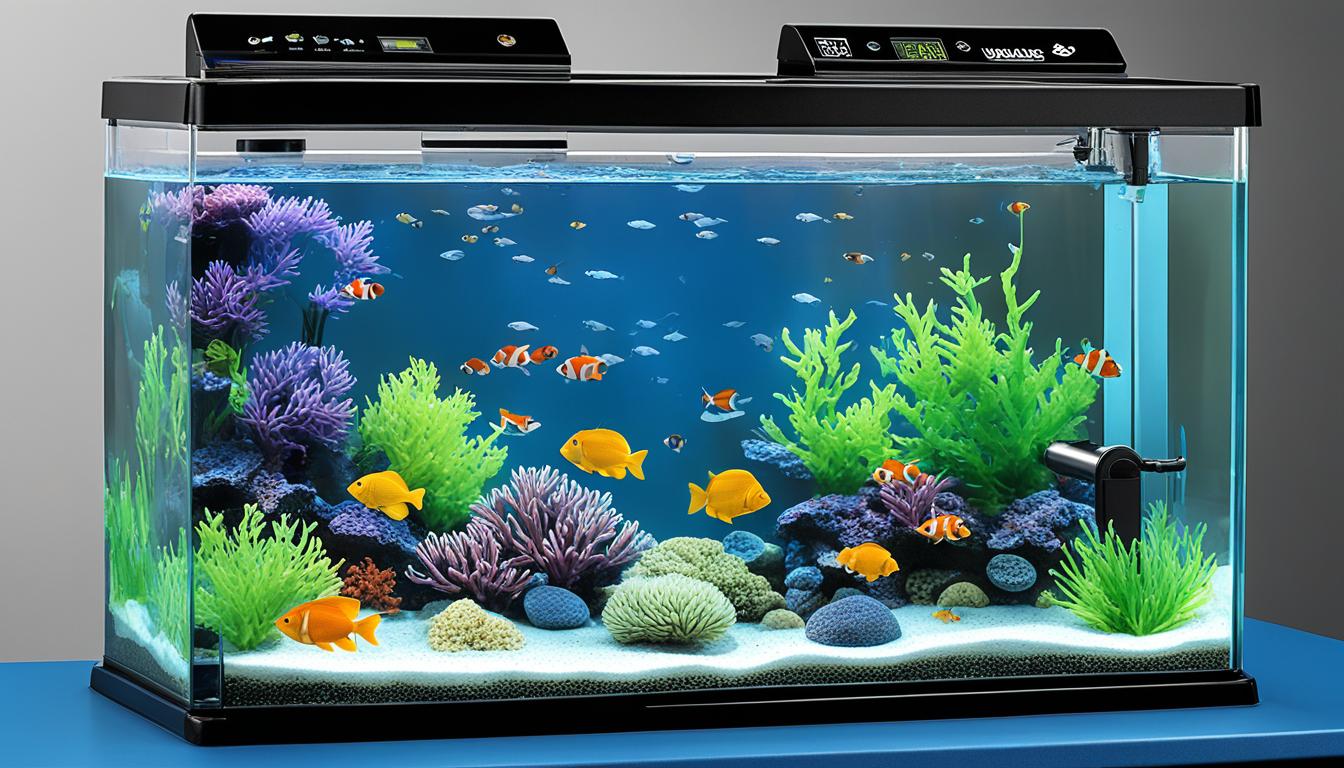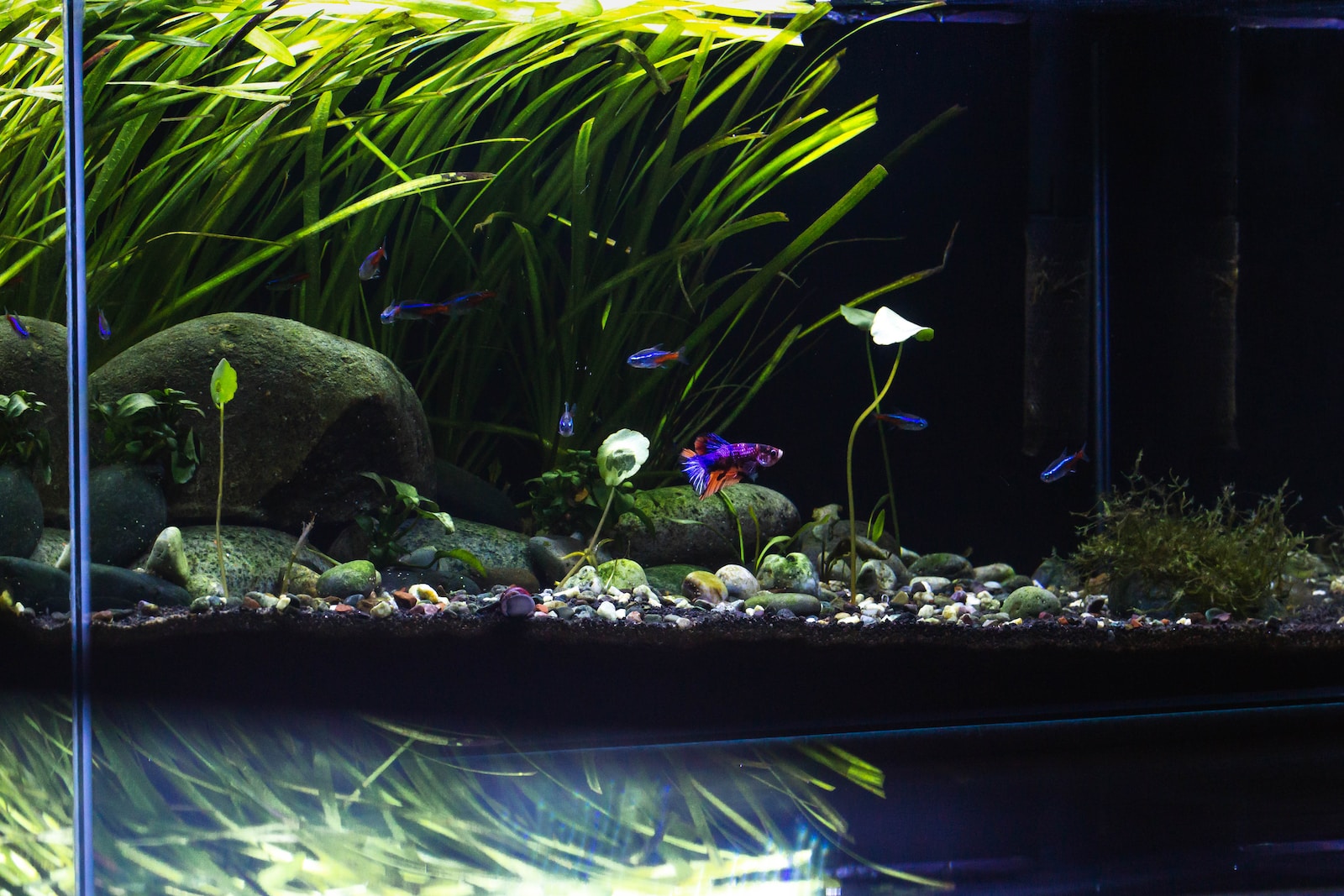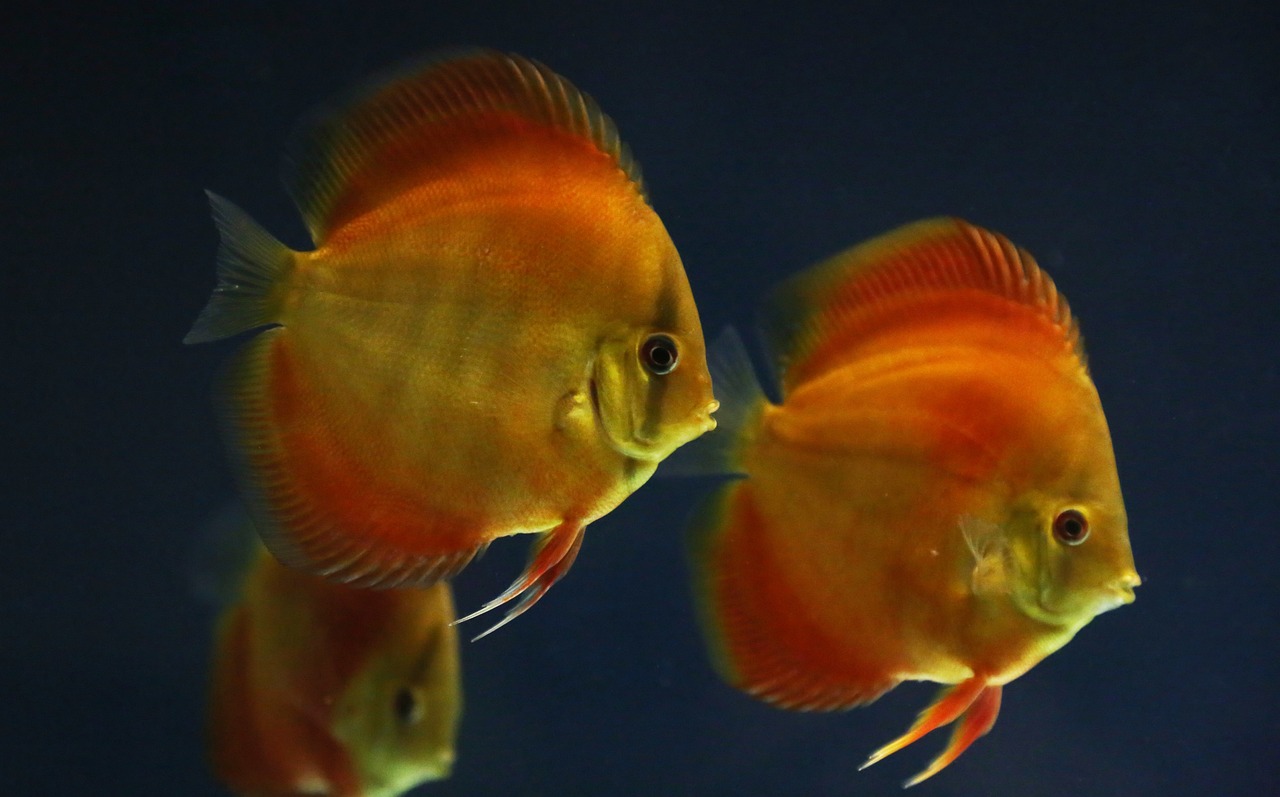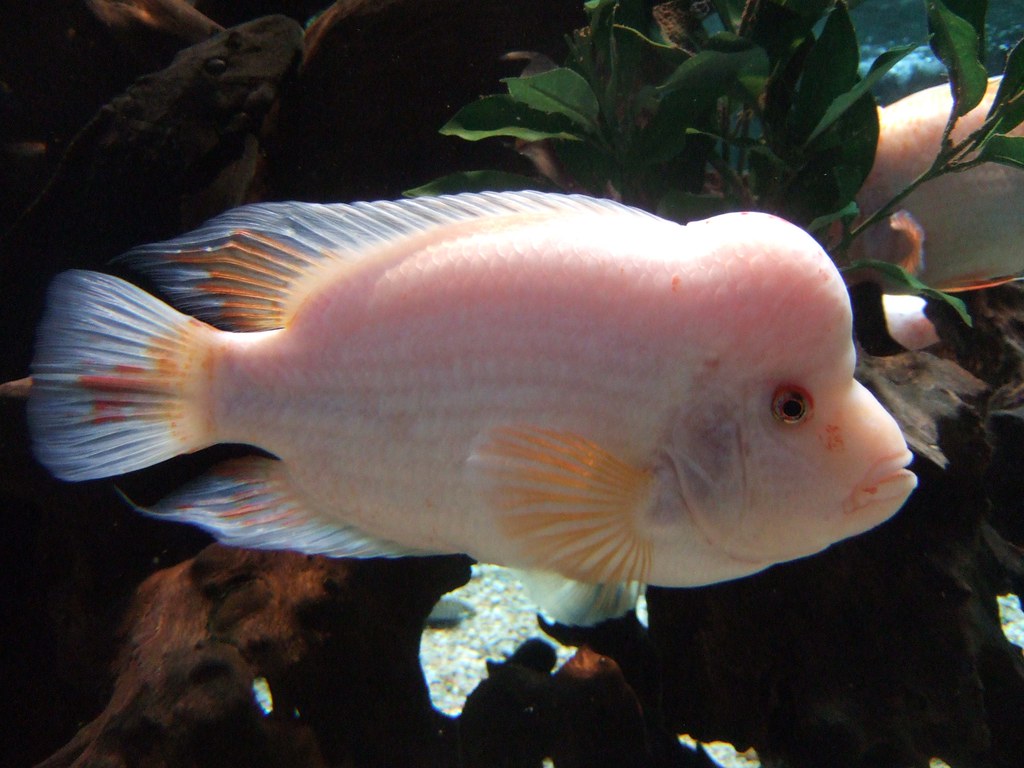Quarantine Tanks: Did you know that 90% of fish deaths in aquariums come from adding sick fish? This is a huge number.
Keeping your fish healthy is so important. One way to do this is by using a quarantine tank. It’s a special tank for new or sick fish. This keeps your other fish safe from diseases.
I’m going to show you how to set up a quarantine tank. I’ll also share why it’s important and some tips for success.
Table of Contents
Quarantine Tanks Key Takeaways:
- Adding sick fish to your tank can cause many deaths.
- A quarantine tank lets you check and treat new or sick fish separately.
- It’s very important to have a quarantine tank to protect your fish.
- Watch your fish closely, treat the water right, and use medicine when needed.
- Quarantine tanks help stop diseases and keep your fish safe.
Materials Needed for the Hospital Tank
Setting up a hospital tank is a must to keep your aquarium fish healthy. You need the following materials for a successful setup:
Clear Plastic Tub or Aquarium with a Lid
A clear plastic tub or aquarium with a lid is best for a quarantine tank. It lets you watch the fish easily while keeping them inside.
Aquarium Filter with Low Flow
An aquarium filter keeps the water clean in the hospital tank. A sponge filter is good because it cleans gently, not bothering the fish.
Aquarium Heater and Thermometer
Keeping the right temperature in a quarantine tank is key. An aquarium heater keeps the water warm. A thermometer lets you check the temperature.
Aquarium Decorations and Hides
Decorations and hiding spots in the tank help fish feel less stressed. Pick decorations that are simple to clean and safe for the fish.
Water Conditioner
You need a top-quality water conditioner to make tap water safe. It removes chlorine, chloramine, and heavy metals, creating a better home for the fish.
Quarantine Medications
It’s key to have medicines ready for treating fish diseases. Choose medications carefully, based on what your fish might need during quarantine.
| Material | Description |
|---|---|
| Clear Plastic Tub or Aquarium with a Lid | A clear container with a secure lid to house the fish in quarantine. |
| Aquarium Filter with Low Flow | A sponge filter or similar type of filter that provides gentle filtration. |
| Aquarium Heater and Thermometer | A heater to maintain a stable temperature and a thermometer to monitor it. |
| Aquarium Decorations and Hides | Hiding spots and decorations to create a comfortable environment. |
| Water Conditioner | A high-quality water conditioner to remove harmful chemicals from tap water. |
| Quarantine Medications | A trio of medications for treating fish diseases during the quarantine period. |
Be sure to have these materials ready. This way, you can set up a hospital tank fast and well. A well-stocked quarantine tank means a safe, healthy place for your fish. This lets you watch over their health and treat any sickness they might get.
Setting Up a Quarantine Fish Tank
Setting up a quarantine fish tank is very important. It ensures a safe and healthy spot for new or sick fish. Proper set-up stops diseases from spreading and gives the best care. Here are the main steps for creating a quarantine tank:
- Choose the location: It’s best to keep the quarantine tank away from your main tank. This stops germs from spreading. You can watch the new fish closely without risking your current fish’s health.
- Prepare a plastic tub: Using a plastic tub? Make some changes for it to work well. Drill holes for air and cut out a spot for cables and tubing. These steps make setting up your tank smooth and easy.
- Mark gallon measurements: Marking the tub makes changing water and adding medicine easier. This helps keep the water right and makes sure you use the correct amount of treatment.
- Fill the tank with water: Now fill your tub with water. Use water without chlorine and add a conditioner to remove bad stuff. This makes the water safe for your fish.
- Install necessary equipment: Set up a filter and heater to keep the water perfect for your fish. Adding places for fish to hide makes them feel safe.
- Ensure water quality: Before adding fish, check the water’s temperature, pH, and ammonia. These need to be right for the fish you’re adding. Keeping these levels correct keeps your fish healthy.
- Add water conditioner: Adding a water conditioner makes the water even safer. It gets rid of chlorine, making the tank a better place for your fish.
By doing these steps, you make a great quarantine tank. It keeps your new and current fish safe. This lets you safely move them to the main tank after their quarantine.
| Key Steps | Description |
|---|---|
| Choose the location | Place the quarantine tank in a separate area to prevent cross-contamination. |
| Prepare a plastic tub | Drill holes for air flow and create a small opening for cables and tubing. |
| Mark gallon measurements | Make it easier to measure water changes and medication dosing. |
| Fill the tank with water | Use dechlorinated water and a water conditioner to remove harmful chemicals. |
| Install necessary equipment | Set up an appropriate filter, heater, and decorations to create a suitable environment. |
| Ensure water quality | Monitor and adjust water parameters for optimal conditions. |
| Add water conditioner | Treat the water to remove residual harmful substances. |
Proper setup of a quarantine tank is key for your fish’s health. With careful preparation, you can protect your aquarium. This keeps your fish safe and your aquarium ecosystem stable.
Observing and Treating Fish in the Quarantine Tank

After setting up the quarantine tank, add the fish and start watching them. You want to catch any illnesses or strange behaviors early. This helps prevent diseases from spreading in your aquarium.
If you notice a fish looks sick, act fast to help it heal. **Treating sick fish in a quarantine tank** means figuring out what’s wrong. Then, you pick the right medicine for that problem.
Before you give any medicine, **remove chemical filtration** from the tank. This stops the medicine from reacting with things like activated carbon. That way, the medicine works like it should.
Spotting diseases in fish can be tough, even for those who’ve done this a while. Look for signs like white spots, damaged fins, weird behavior, or not eating. If you’re not sure what the issue is, it’s best to treat new or unknown fish right away.
A **proactive treatment** means using medicine that fights many diseases at once. This approach is good for keeping your fish safe while they get used to their new home.
Always follow the medication instructions carefully. This includes how much to use and for how long. Giving too much can hurt the fish.
| Fish Disease | Symptoms | Treatment |
|---|---|---|
| Ich (Ichthyophthirius multifiliis) | White spots on the fish’s body and fins, rapid breathing, rubbing against objects | Medication containing malachite green or copper |
| Fungus (Saprolegnia) | White cotton-like growth on the fish, open sores | Medication containing malachite green or potassium permanganate |
| Fin Rot (Columnaris) | Frayed or rotting fins, loss of appetite, lethargic behavior | Antibiotic medication |
Keep an eye on the fish in the quarantine tank while they’re being treated. **Observing fish in the quarantine tank** lets you see if they’re getting better. You’ll know if they need more treatment.
When treatment is done and the fish are healthy, they can move to the main tank. But it’s important to keep watching them. You want to make sure they settle in well to their new home.
Completing the Quarantine Process
It’s vital to finish the quarantine after 4-6 weeks. This ensures your fish are healthy before joining the main tank. There are several important steps to follow during this last phase.
Completing the Quarantine Period
The first step is finishing the quarantine as recommended. Start counting from the last time you saw any disease symptoms or fish deaths. This helps to avoid spreading diseases or parasites to your main tank.
Water Changes for Quarantine Tank
Changing the water regularly is key during quarantine. Aim for weekly changes of 20-30% of the water. This keeps the water clean and healthy.
Building Fish Immune Systems
Feed your fish high-quality food while they’re in quarantine. Good nutrition boosts their immune systems. For the best food, talk to a fish expert or a trusted brand.
Releasing Isolated Fish from Quarantine
Before moving fish from quarantine to the main tank, do one last health check. Add two healthy fish from the main tank to the quarantine. Watch them for a few days. If everyone is healthy, you can move the fish to the main tank. This makes sure your fish are safe and healthy.
Following these steps makes the quarantine process successful. Taking these precautions keeps your fish and your aquarium safe and healthy.
Cleaning and Maintenance of the Quarantine Tank
After using your quarantine tank, cleaning it is vital for future use. Cleaning and storing it properly keeps it ready. Follow these steps to keep your equipment in good shape:
Cleaning the Quarantine Tank
1. Drain the water using a siphon or bucket. Make sure to dispose of the water correctly.
2. Scrub the tank with a safe cleaner. Then rinse everything well with clean water.
3. Clean the filter components carefully to remove bacteria. Use the instructions to clean the filter right.
4. Rinse the tank parts with fresh water to take out any cleaner left.
5. Let all parts dry completely. This stops harmful bacteria from growing.
Storing the Quarantine Tank Setup
1. Store your clean setup in a cool, dry place. Avoid places with big temperature changes or a lot of moisture.
2. Cover the tank with a cloth to keep dust away. This helps keep it clean.
3. Put the filter, heater, and other parts in a safe spot. You can use their original boxes.
4. Check the stored equipment regularly for damage. Replace anything that’s broken or old when needed.
Preparing for Future Fish Purchases
If you plan to get more fish, keep your quarantine tank ready. By keeping the equipment in good condition, you make sure it’s safe for new fish. Make sure to:
- Test the water in the quarantine tank regularly. This ensures it’s good for the fish.
- Do regular upkeep like changing the water and cleaning the filter. This keeps the tank in top shape.
- Have quarantine medicines and supplies ready for any sick fish.
By sticking to these cleaning, and maintenance tips, and getting ready for new fish, your quarantine tank will always be reliable. This keeps your fish healthy and happy.
Do You Really Need a Quarantine Tank?
A quarantine tank is vital in fishkeeping. While some see it as an extra cost or effort, its role in protecting your fish’s health is critical. It benefits both freshwater and saltwater fish.
Freshwater fish usually face fewer diseases than saltwater fish. Yet, a quarantine tank is still crucial for them. It offers a special area to watch for signs of sickness in new fish. Freshwater fish can carry pathogens or parasites that threaten your existing fish, making a quarantine tank a protective layer.
Saltwater fish, often caught from the wild, are more at disease risk because of the stress from being caught and transported. The balance of a saltwater ecosystem is delicate. So, having a quarantine tank is even more important. It lets you treat diseases before mixing new fish with your old ones. This step is key to keeping your fish and saltwater aquarium healthy.
Understanding the importance of a quarantine tank highlights the need for one. Setting up and maintaining a quarantine tank means you are acting to keep your fish healthy. It is always better to prevent disease than to deal with its aftermath in your aquarium.
Let’s examine the value of quarantine tanks for both freshwater and saltwater fish:
| Quarantine Tank for Freshwater Fish | Quarantine Tank for Saltwater Fish |
|---|---|
| Provides a controlled environment | Protects against diseases and parasites |
| Allows close monitoring of new additions | Prevents introduction of pathogens |
| Minimizes risk to existing fish | Maintains overall health and stability |
As shown, quarantine tanks for both types of fish keep your fish safe from dangers. Though the details may differ based on your fish type, the key point stays the same. A quarantine tank is vital for your fish’s welfare and your aquarium’s health.
In summary, we cannot ignore the importance of a quarantine tank. Having a special spot to observe, treat, and acclimate new fish is key for a thriving aquarium. Taking the steps to create a proper quarantine tank ensures a successful fishkeeping experience.
Quarantine Tank Setup for Freshwater Fish
Setting up a quarantine tank is crucial for your fish’s health. You should think about the tank setup, size, and filtration. These elements help create a healthy spot for your fish.
Tank Size and Setup
A tank between 10-20 gallons is ideal for quarantining freshwater fish. It has enough room for fish to swim. Plus, it helps keep water conditions stable, making fish less stressed.
It’s vital your quarantine tank has the right equipment. An air-driven filter is best as it’s gentle on the fish. Also, a steady heater is key to keep the temperature just right, like in their main tank.
Add some decorations, like plants or caves, to make fish feel safe. This eases their stress and keeps them healthy. Watching the water’s temperature, pH, and toxin levels closely is also crucial.
Filtration for Freshwater Fish Quarantine Tank
Filtration keeps the water clean and healthy in a quarantine tank. It removes harmful substances, keeping the fish safe.
An air-driven filter, like a sponge filter, is a good pick for quarantine tanks. It provides a mild flow and helps beneficial bacteria grow. These bacteria are vital for getting rid of harmful ammonia and nitrite.
Clean the filter regularly to keep it working well. Replace sponges or media as needed to avoid clogs and keep the water clear.
With these tips, you can create a great quarantine space for your fish. It helps them stay stress-free and healthy while being quarantined.
Next, we’ll look at how to set up a quarantine tank for saltwater fish. We’ll focus on their special needs.
Quarantine Tank Setup for Saltwater Fish
Saltwater fish are more prone to diseases due to stress from captivity and transport. They need a quarantine tank to reduce infection risks. Setting up a quarantine tank right is key to keeping your fish safe and healthy.
Appropriate Tank Size for Saltwater Fish Quarantine
Choosing the right tank size is crucial. It should meet the fish’s needs and allow room for proper filtration. Always use a tank that’s at least 10 gallons to let the fish swim freely. But bigger tanks, like 20 gallons, are better because they keep the water conditions more stable.
Large tanks also dilute medicines better. Just make sure not to fill them too much. Too many fish can lead to more stress and disease.
Filtration for Saltwater Fish Quarantine Tank
Good water quality needs the right filtration in a quarantine tank. Sponge filters driven by air are great because they offer both mechanical and biological filtration. This setup lets beneficial bacteria thrive without stressing the fish too much.
It’s also smart to add activated carbon for chemical filtration. But take it out when treating illnesses. This makes sure the medicines work well.
Other Considerations
Aside from tank size and filtration, keep in mind a few more things for your quarantine tank:
- Heater: Stable temperatures are critical for saltwater fish. Use a reliable heater to keep the water just right.
- Decorations: Adding places to hide, like live rocks or fake decor, helps lower stress and make fish feel safe.
- Water Parameters: Regularly check the water for salinity, pH, ammonia, nitrite, and nitrate. This helps catch problems early.
Watch your fish closely for signs of sickness. Record any odd behavior or symptoms. With the right setup and careful monitoring, you can keep diseases away from your main tank. This ensures your saltwater fish remain healthy and happy.
| Tank Size | Filtration | Heating | Decorations |
|---|---|---|---|
| 10 gallons or larger | Air-driven filters | Reliable aquarium heater | Live rocks or artificial structures |
Coral Quarantine

Putting coral into quarantine before it joins the main tank is key to stop diseases. Using **coral dipping** is a top method to clear out pests and illnesses from foreign coral. Proper quarantine steps protect your aquarium’s health and cut the risk of bad pathogens.
In the quarantine phase, dipping the coral in solutions like CoralRx or Tropic Marin Pro Coral Cure is advised. These products cleanse and remove parasites, pests, or harmful bacteria. They protect the coral and other tank life.** Preventing coral diseases** is crucial for a healthy and disease-free coral reef aquarium.
Quarantine not just keeps the coral safe but also the fish and plants already in your aquarium. Imported coral might bring diseases that spread quickly. Quarantine lets you check the coral for diseases or stress before it goes into the main tank.
Adding a quarantine process for coral into your care routine is smart and forward-thinking. It checks the coral’s health, adjusts it to the new setting, and reduces risks it might carry.
Remember, stopping diseases is better than treating them. Following correct quarantine steps and practicing **prevention of coral diseases**, your coral reef ecosystem stays healthy and bright for years.
Benefits of Coral Quarantine
Quarantine is vital for your coral reef aquarium’s health. Here are major benefits of coral quarantine:
- Prevents disease spread in your tank.
- Gives a chance to check coral health before it enters the main tank.
- Lets you treat any diseases found during quarantine.
- Reduces the risk of pests and harmful organisms in the main tank.
- Eases coral stress through gradual acclimation to the new environment.
Quarantine ensures your coral’s well-being and keeps your aquarium’s ecosystem balanced and harmonious.
Best Practices for Quarantine Tanks
Having a quarantine tank is key to keeping your fish healthy and stopping diseases from spreading. By using best practices for water treatment and proper medication, you can keep your fish happy. Quarantine tanks play a big role in this process.
Water Treatment for Quarantine Tanks
Creating the right environment in a quarantine tank starts with treating the water right. Before adding fish, you must take out chlorine with a water conditioner. This makes the water safe and reduces stress for the fish.
Keeping an eye on water quality is also essential. You should check the temperature, pH levels, and ammonia regularly. This helps to make sure the fish stay healthy while in quarantine.
Use of Medications in Quarantine Tanks
It’s important to use medications in quarantine tanks correctly. Always follow what the medication instructions say. If needed, ask a vet for advice.
Medications can help treat diseases or parasites in new fish. But, remember to take out any chemical filtration like activated carbon before adding meds. This way, the meds can work without being removed by the filter.
Benefits of Quarantine Tanks
Quarantine tanks do more than just protect your existing fish. They let you watch new fish closely for any health problems. This can catch issues early.
They also let fish adjust to your main tank’s water slowly. Quarantining new fish lowers the risk of bringing in diseases or parasites. This protects your other fish.
Quarantine tanks also give fish a place to get over the stress of moving. They’re a spot where sick or hurt fish can get better. This is done without putting other fish at risk.
Overall, quarantine tanks are crucial for keeping your aquarium successful. By focusing on good water treatment, using medications wisely, and understanding their benefits, you can make a great home for your fish.
| Best Practices for Quarantine Tanks | Water Treatment for Quarantine Tanks | Use of Medications in Quarantine Tanks | Benefits of Quarantine Tanks |
|---|---|---|---|
| Dechlorinate water with a water conditioner | Monitor and maintain appropriate water parameters | Follow medication instructions and remove chemical filtration | Protect existing fish and prevent disease spread |
| Regularly observe behavior and health of new fish | Ensure proper acclimation before introducing to main tank | Minimize risk of introducing diseases and parasites | Provide a safe space for fish to recover and receive treatment |
Conclusion
Quarantine tanks are super important in fish keeping. They give a safe space for new or sick fish. This allows for close watching of the fish’s health.
These tanks let you treat fish right to stop diseases from spreading. Setting up and keeping a quarantine tank well ensures your fish community stays healthy. Keeping these tanks well is key to protect your fish and stop bad outbreaks.
Making a good quarantine space is like investing in your fish’s health. This space helps your fish live in a place free from disease. It’s all about giving your fish the best chance to do well.
In summary, quarantine tanks are essential, not just an extra. They keep your fish healthy and your aquarium successful. By using quarantine tanks, you’re helping your underwater pets and their home be the best they can be.
FAQ
What is a quarantine tank?
A quarantine tank is a special tank for new or sick fish. It’s used to check their health. This keeps diseases from spreading.
What materials do I need for a quarantine tank?
You need a few things for a quarantine tank. These include a plastic tub or an aquarium with a lid, a gentle filter, a heater, and a thermometer. Don’t forget aquarium decorations, water conditioner, and medicines.
How do I set up a quarantine fish tank?
Set the quarantine tank in another room, away from your main tank. If using a plastic tub, make holes for air and a slot for cables. Add water, treat it, and put in the filter, heater, and decorations.
How do I observe and treat fish in the quarantine tank?
Watch your fish’s looks and how they act in the quarantine tank. For sick fish, use the right medicine. If you’re not sure what’s wrong, a set of three medicines can help. Take out chemical filters before putting medicine in.
How long should I quarantine new fish?
Keep new fish in quarantine for 4-6 weeks after the last sign of illness. Change the water every week. This gets rid of leftover medicine.
How do I clean and maintain the quarantine tank?
Once quarantine is done, clean the tank and dry it. If you’re getting more fish later, keep the gear ready.
Do I really need a quarantine tank?
Whether you need a quarantine tank depends on your fish. Freshwater fish often get less sick and might not need one. But, saltwater fish from the ocean need it to stay healthy.
How should I set up a quarantine tank for freshwater fish?
A good size for a freshwater fish quarantine tank is 10-20 gallons. Use air filters, a heater, and decorations for hiding. Keep an eye on the water and watch the fish closely.
How should I set up a quarantine tank for saltwater fish?
For saltwater fish, start with at least a 10-gallon tank. It needs air filters, a heater, and decorations too. Always check the water and watch your fish during quarantine.
Why is coral quarantine important?
Quarantining coral stops diseases from spreading in your main tank. Dipping coral in products like CoralRx or Tropic Marin Pro Coral Cure can kill pests and diseases.
What are the best practices for quarantine tanks?
The top tips for quarantine tanks are to treat the water right, use medicines wisely, and know how quarantine can protect your fish from disease.
References
- International Federation of Online Clubs and Aquatic Societies (IFOCAS)
- Federation of British Aquatic Societies (FBAS)
- Northeast Council of Aquarium Societies (NEC)
- Federation of American Aquarium Societies (FAAS)
- Ornamental Aquatic Trade Association (OATA)
I am a passionate aquarist with over 30 years of hands-on experience in fishkeeping. My journey began at a young age, collecting fish from the wild and learning through experimentation. Specializing in tropical fish, I bring a deep understanding of the hobby to FishKeepingMadeSimple. The site provides honest, detailed reviews of essential products and accessories to help fellow enthusiasts create the best environments for their fish.









